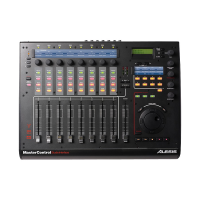Chapter 2: Playing the A6
ANDROMEDA A6 REFERENCE MANUAL 69
THE CLOCK SECTION
The A6’s Clock is a
global function that
provides global
synchronization as a
modulation source to
all voices in Programs
or Mixes. By global sync
we mean that any A6
function that relies on
tempo can get its
timing from the Clock.
The timing can be
steady or variable.
Some examples of A6
functions that rely on
tempo are the
Sequencer and the
Arpeggiator. You can
also slave modulation sources such as LFO rates and Envelope stages to the Clock
when their timing needs to coincide with a song’s tempo. Normally, the A6’s LFOs
run independently of the Clock as they have their own generators for
RATE. The same
applies to Envelopes whose stages are normally timed by their own circuitry. But
when the need arises to synchronize one or more LFOs or Envelope stages to a
common tempo, this is accomplished by slaving the desired destination to the Clock.
Conversely, you can modulate the Clock’s tempo by an LFO or Envelope or any of
the A6’s 71 modulation sources. This is accomplished using
SYNC/MOD as described
below.
How the A6’s clock is integrated with the Sequencer and Arpeggiator is covered in
the following topics. Slaving an LFO to the Clock is covered in Chapter 7. Slaving an
Envelope stage is discussed in Chapter 6.

